The Pacific Northwest is home to a bunch of interesting antique stores. A couple of years ago, I was browsing musical antiques at a shop in Bellingham, WA. Among the vintage records, accordions, and old sound systems, my attention was drawn to a stack of flat, ornate looking stringed instruments. Turns out, I had come upon a pile of zithers.
What is a zither?#
A zither is a stringed instrument where strings are stretched over a thin, flat body without extending onto a separate neck or fingerboard. Think of an acoustic guitar or a cello - these instruments are not zithers because their strings span the entire body of the instrument, past the sounding box and onto necks. (Plus, neither instrument is thin, nor flat.)
There are several categories of zithers; I think tube zithers are particularly cool. To most, the prototypical zither looks and sounds like this:
To my untrained eye, a zither looks like a tiny harp with several strings (some clustered together) and a fretboard. I think you’d call this a concert zither, which is a type of zither popular in Eastern Europe. I didn’t find any concert zithers in Bellingham though; I found chord zithers, which are more common in North America.
Chord zithers#
As the name implies, chord zithers make it easier to play chords. To me, a chord zither is distinguished by some special set of strings (or some special set of buttons) that are used to play chords instead of notes.
The autoharp is a relatively well-known chord zither. Fans of 60s pop might remember that Do You Believe in Magic by The Lovin’ Spoonful features the autoharp:
Hidden beneath the autoharp’s “plate” of buttons, there are several bars affixed with soft pads. When an autoharp’s chord button is pressed, the bar is lowered onto the strings and pads will mute all strings except for the strings needed to produce a given chord.
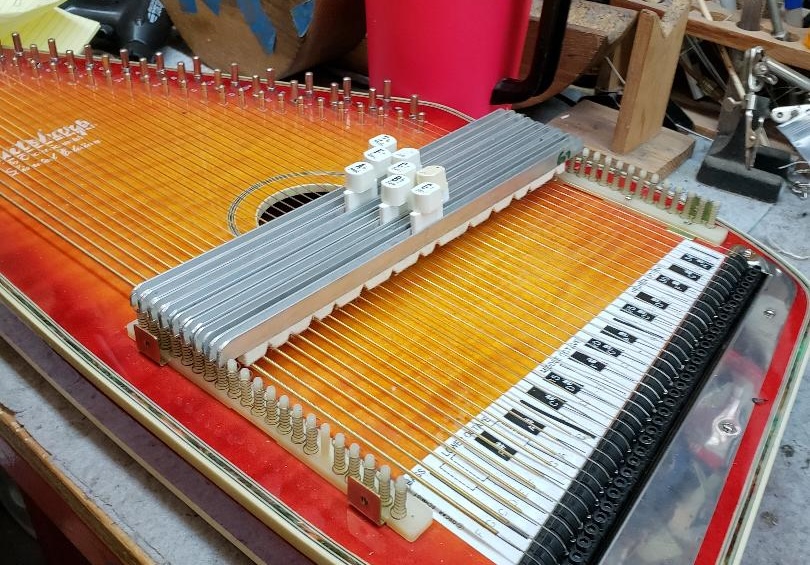
In the 80s, Suzuki released the Omnichord, which is basically an electronic/synthesized version of an autoharp. Omnichords offer the same “button chording” functionality as the autoharp, but the two instruments sound very different:
I’ve been looking for a new instrument to learn, so I tried to learn more about chord zithers when I got home from antiquing. As I watched various Youtube videos and scraped the autoharp subreddit, I could see myself playing around with these instruments, but I wasn’t quite sold yet. I was determined to find my zither soulmate.
As I continued my exploration of the zither family, I eventually encountered the tremoloa.
Tremoloa#
The tremoloa is a really, really weird zither.
The body of the tremoloa is dominated by a steel arm which supports a weighted rolling bar. The “melody string” running along the bottom of the instrument can be plucked using a plectrum at the end of the arm. When the melody string is plucked, the string vibrates against the weighted bar, which produces a janky, ghoulish sound. Acommpanying notes can be played with the left hand using the strings that run along the top of the instrument.
If the autoharp is niche, then the tremoloa is on another plane of niche existence. This is a fretless instrument - those markings near the melody string may seem fret-like, but from what I understand, they’re not very helpful when playing. I was disappointed to learn that tremoloa is so difficult to learn, because I was getting soulmate vibes from this barred stringed zither.
In my research, I found that the tremoloa was created as an attempt to market Hawaiian steel guitar to American consumers.
What is steel guitar?#
I’ve always found the phrase ‘steel guitar’ a bit confusing. Having played classical guitar - which use soft nylon strings instead of steel strings - I used to wonder, is a ‘steel guitar’ just… a regular guitar?
Steel guitar specifically refers to guitar that’s played with a bar (or some other object) pressed against its strings.
If you’re familiar with blues, you might be familiar with the picture of someone playing a standard acoustic guitar with a metal or glass tube on a fretting finger finger. The tube is slid across the fretboard, producing a distinctly twangy, resonant tone when the strings are plucked with the other hand. Folks also refer to this playing style as “slide guitar”.
Slide guitar is typically played upright - the guitar body held against the player’s body with strings facing outward - much like the playing position you’d use with standard electric or acoustic guitar.
This technique likely originated in Hawaii, where it became known as Hawaiian steel guitar. Unlike upright slide guitar, Hawaiian steel guitar is typically played with the guitar laid horizonally across the musician’s lap. One hand glides a tone bar along the fretboard to alter pitch, while the other hand picks or strums the strings. Hawaiian steel guitar is associated with C6 tuning - also known as open C (C-E-G-A-C-E) - which contributes to a unique melodic quality that sets it apart from blues-style steel guitar.
I’m grateful for Hawaiian steel guitar because it helps me provide others with a point of reference when I’m talking about pedal steel. People my age aren’t always familiar with pedal steel, but most of them have seen SpongeBob.
Hawaiian steel guitar made its way to the continental United States in the early 1900s and became wildly popular. As I mentioned before, blues and rock adopted the upright style of slide guitar. Classic lap style slide guitar became widely known in various genres as lap steel guitar.
Lap steel guitar#
Lap steel guitars look like electric guitars with bodies trimmed down to lap size.
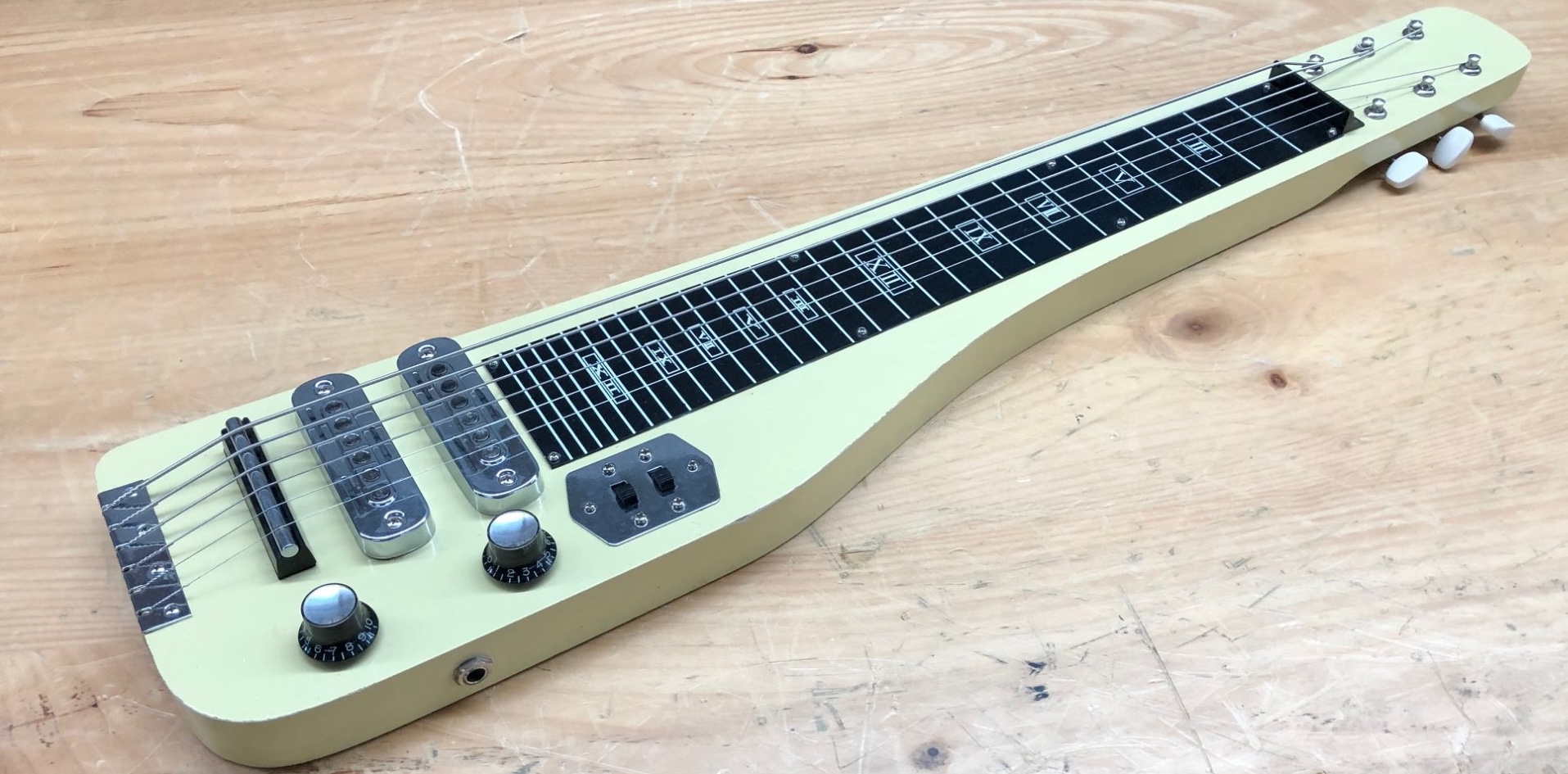
Lap steels are six-stringed instruments, and C6 is still a popular tuning for lap steel. Of course, other tunings are possible - the key challenge of lap steel lies in selecting the best tuning and developing the technique to achieve the harmonies, smooth transitions, and expression that best suit a particular song.
If an autoharp is the pedal steel’s cousin, then the lap steel is its younger brother - similar in spirit, but simpler and more approachable. Many beginner-level pedal steel songs are playable on lap steel, which makes it a great entry point into this style of playing. They’re also affordable, with excellent used models available in the $200 range. Lap steel probably deserves its own dedicated series; I haven’t sourced one yet, but it’s definitely on my list.
Note
When I was deciding on my entry point into steel guitar, I found that a lot of folks argue, “If you want to learn pedal steel, learn pedal steel. If you want to learn lap steel, learn lap steel. The basic technique is similar, but the instruments are different enough that most essential skills are not transferrable.”
Initially this argument persuaded me, but my perspective has changed after getting my own pedal steel. Pedal steel guitars are expensive, and if you’ve never played an instrument like this (or if you’ve never played an instrument at all), you’re taking a leap of faith.
For ~$100, you can buy a used lap steel and learn the basics of picking, barring, and theory. If you enjoy learning and playing lap steel, you’ll have a better idea of whether the pedal steel plunge makes sense for you.
As lap steel guitars grew in popularity, enhancements were introduced to improve their ergonomics and functionality. One notable advancement was the addition of palm levers (also known as benders).
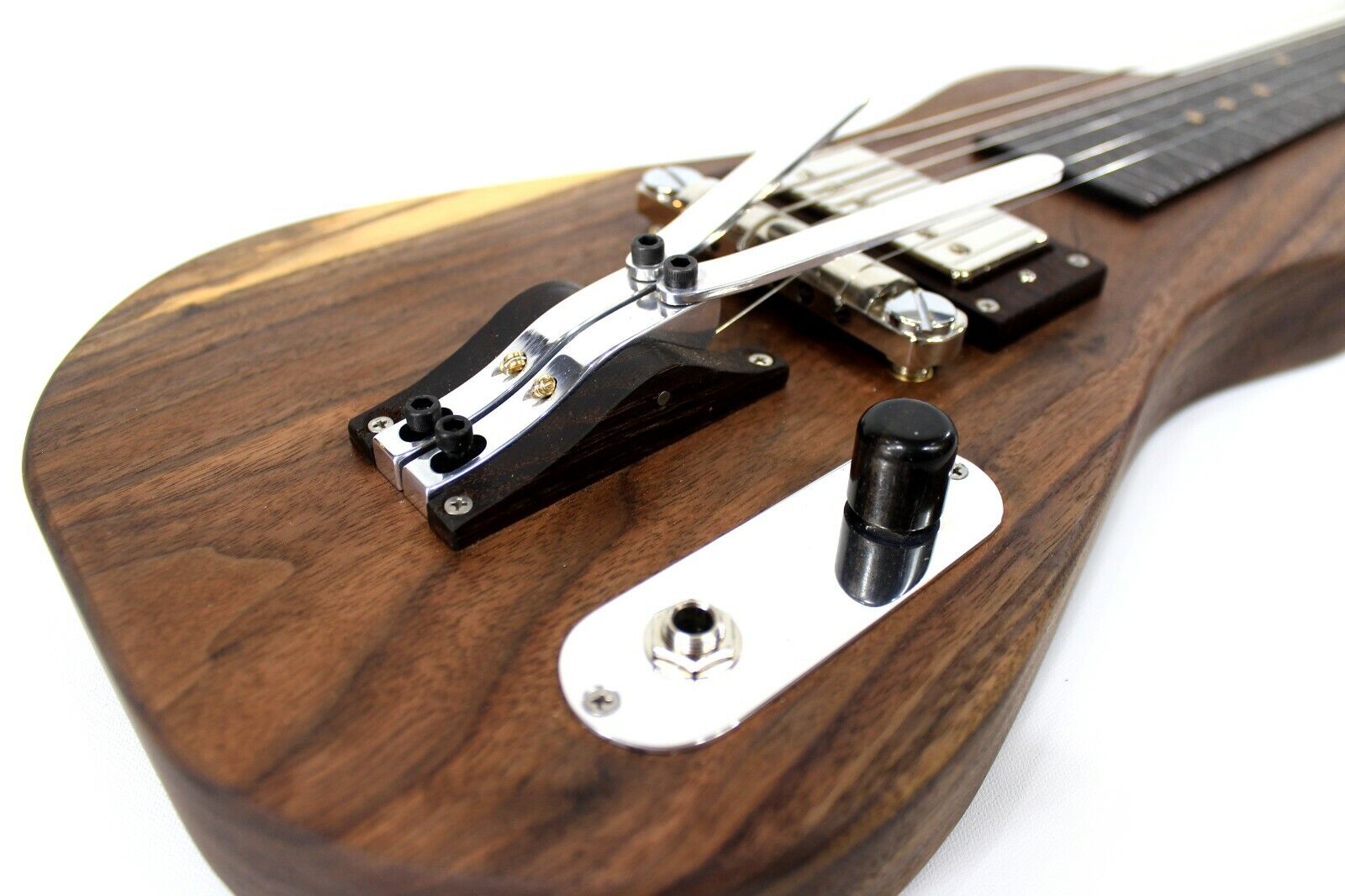
Today, you can buy these palm levers separately and install them on most lap steel models. When activated, each lever pulls its corresponding string, instantly raising or lowering its pitch. This quick shift in pitch produces a distinctive and expressive sound. In this video, notice how the notes change as each palm lever is pressed:
Console steel guitar#
Eventually, lap steels were produced with multiple necks - usually two, but nutjob guitars like this Fender Quad Stringmaster featured four necks.
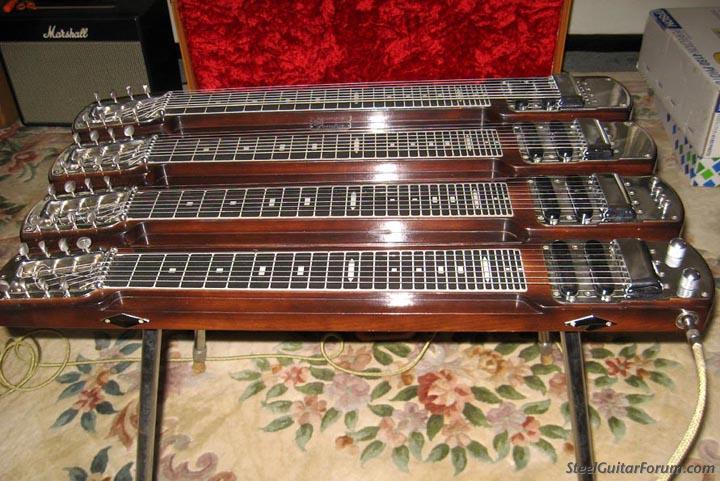
The idea behind multiple necks was to let players quickly alternate between tunings without retuning between songs. However, these necks added weight and size, so the guitars were often mounted on four-legged stands and called console steel guitars. Musicians play console steel either seated or standing behind the console.
Aside from adding necks, console steel guitars also added strings. Many came equipped with eight strings instead of the usual six.
Info
On a two neck console steel guitar, it’s common for one neck to be tuned to C6 and the other neck tuned to E9 (E-G♯-B-D-F♯-G♯-B-E). This eight string E9 tuning is associated with Western swing, a delightful genre that combines elements of country, blues, and jazz. Pedal steel has its own E9 tuning, also known as Nashville E9 (B-D–E–F♯–G♯–B–E–G♯–D♯–F♯).
In my eyes, Santo & Johnny’s Sleep Walk will always be the most iconic steel guitar song ever recorded. In this recording, Santo plays on a three-neck Fender Stringmaster console steel guitar:
According to folks on the Steel Guitar Forum, the liner notes of Legends Of Guitar: Rock, 1950s, Vol. 2 quote Santo as saying: “I [was tuned] to C#m7 on one neck… A6 on another, and E7 on the third neck. Basically, I could play Sleep Walk on any of the necks, but I recorded it with the C#m7.”
With multiple necks, palm levers, and additional strings, the steel guitar had evolved into a vibrantly expressive instrument and found its place in mainstream music. With a few more innovations, it would reach its final evolution: pedal steel guitar.
Pedal steel guitar#
As its name implies, the pedal steel was born when foot (or floor) pedals were integrated into console steel guitars. The first pedal steel guitar was designed by Paul Bigsby in the late 1940s. His Bigsby two-pedal steel guitar was famously played by Speedy West, one of the most acclaimed steel guitarists of all time.
Bigsby positioned pedals on a rack between the two front legs of a console steel, connecting each pedal to a mechanical system that applied tension to the strings above. While similar in concept to lap steel palm levers, floor pedals can simultaneously alter the tension of multiple strings (like an autoharp). The internal mechanisms supporting pedals are intricate and compact, and pedal configurations can vary significantly between different pedal steel models.
Since pedals were operated by foot, it was much easier to apply tension to a string while note was still sounding. This iconic pitch-bending sound has become the hallmark of pedal steel guitar. (Today, palm levers are marketed as enabling “pedal steel sound” in lap steel guitars.)
Info
The pedal steel guitar was developed further by Buddy Emmons in the late 1950s. He’s credited with introducing the ten-string neck (ushering in the age of Nashville E9 tuning) and refining pedal function. Emmons co-founded Sho-Bud, the first dedicated pedal steel guitar manufacturing company
Some pedal steel guitars also have knee levers, which perform the same function as floor pedals. Knee levers hang from the underside of the pedal steel. The musician activates the knee lever by pressing against it with their knee or inner thigh.
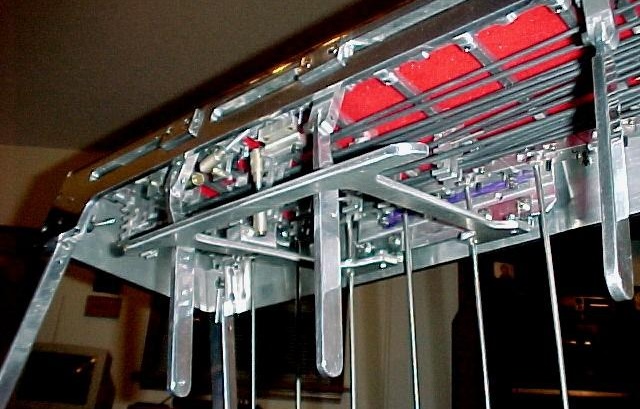
Knee levers are less common than floor pedals, and some student models might not include knee levers at all. Floor pedals tend to be easier to operate, but advanced pedal steel players frequently use both pedals (often two at a time) and knee levers simultaneously to achieve intricate note adjustments.
A classic pedal steel guitar will have three floor pedals and one knee lever. A double necked pedal steel will usually have eight floor pedals. My pedal steel guitar has nine floor pedals and eight knee levers. Since pedal steel guitars are still typically handmade or produced in limited quantities, configurations can vary widely from model to model.
Today, pedal steel continues to find its place in radio-friendly country music. The instrument is undeniably rooted in country and folk, and many pedal steel masters remain devoted traditionalists. However, I’ve always believed its voice-like sound makes it adaptable and well-suited to a wide variety of genres. In my mind, Faye Webster stands out as an artist pioneering non-traditional pedal steel use in popular music:
Ultimately, the pedal steel guitar is a complex, wonderfully expressive instrument. Too bad it’s impossible to learn!
The trouble with learning pedal steel#
I think there are several reasons why pedal steel is inaccessible today:
- Compared to instruments like piano or clarinet, the pedal steel is an obscure instrument. Many people haven’t even heard of it - though they’ve probably heard its distinctive sound without realizing it.
- Student models are ridiculously expensive ($1000+). A used market exists, but since all models are heavy (50+ lbs) shipping is difficult and expensive. Many used pedal steels are available for local pick-up only.
- Variation between models makes it difficult to provide “one sizes fits all” instruction - are you trying to learn C6 tuning without any knee levers, or E9 tuning with 12 foot pedals and 8 knee levers?
- Pedal steels require non-trivial maintenance. Without access to an experienced pedal steel player, new learners often struggle to handle repairs or adjustments independently.
- I’ve spoken with experienced pedal steel players who refer to the instrument as a “theory machine”. The complexity of pedal steel attracts musical theory nerds, which means that most pedal steel resources are dense and hard to understand if you don’t come from a musical background.
Each of these factors has contributed to the pedal steel guitar’s sparse educational landscape.
As I’m embarking on my own journey to learn pedal steel, I’ve found that it’s absurdly difficult to answer basic, beginner-level questions about pedal steel guitar. With this series, I aim to improve the availability of pedal steel learning resources by documenting my research and learnings from a true beginner’s perspective. I’ll start with equipment and setup, then progress into guides covering theory and technique.
Pedal steel may be intimidating, but I love it and I’m eager to demystify it for myself and others. In my next post, I’ll walk through my budget-friendly(ish) beginner’s setup. See you then!
